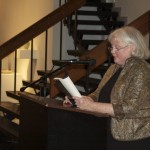Samantha Villanueva
Contributing writer

Four authors were honored at the Arts and Humanities Book Readings Program, held in the Clara M. Eagle gallery on the sixth floor of the Price Doyle Fine Arts building, Thursday night.
Camille Serre, Constance Alexander, Judith Shearer, and Pamela Johnson-Parker presented a taste of their works, prompting the “Girls’ Rule” theme of the night. All four are current Murray State faculty and
Serre, a professor of art and head of the art education department, said she agreed to do the reading on the opportunity of introducing her book to the audience.
“I was invited to participate in the College of Humanities & Fine Arts Book Reading Program to present and sign my book and was happy to do so,” she said. “In addition, the Department of Art & Design held a closing reception of the 2011 Faculty Exhibit in conjunction with the reading in the Clara M. Eagle Gallery.”
Serre’s book, an art textbook titled Recipes for Sculpture, does more than just instruct students how to make food sculptures out of toilet paper, tempera paint, and water; it helps students think outside the box, according to the author.
“Recipes for Sculpture is about methods for creating toilet paper food sculpture and more using toilet paper, water and tempera paint,” she said. “It is an informative, explanatory book that serves as an essential tool for both in-service and pre-service teachers in the development of 3-D (three-dimensional) experiences for all classrooms. It is a jam-packed storehouse of rich imagery and creative ideas that invite the readers to rethink, explore, and develop experiences in sculpture through practical classroom application.”
Constance Alexander, author of Who Needs June Cleaver? , said it was the wanting to inspire students that caused her to say yes to the reading.
“Writers do readings to entertain potential readers and to inspire them to buy the books,” Alexander said. “In addition, readings are a great way for a writer to get an audience’s feedback about their writing.”
Alexander, a lecturer for the vice president academic affairs, said the selections she chose to read all held a personal connection with the audience or reader.
“I read some poems related to Greek mythology because I knew there were students in the audience who are reading the odyssey and other works associated with mythology,” she said, “The poems were from my chapbook, Letters From Down Under. One essay I read, A long Way From St. Lucy, (the June Cleaver book) explains how I became a writer. The second essay, Coming Home, is about change—the changes in the seasons, getting old, and the way we see these aspects of life illustrated in nature, plus 9/22 was the last official day of summer.”
Judith Shearer, an administrative assistant in the Humanities and Fine Arts department and author of All Bones Be White said she agreed to do the reading due to give a proper introduction to her book.
“I agreed to come to the reading because as a writer, for me, I want listeners and readers and it was an opportunity to introduce people to Cassy,” she said.
Shearer’s book tells the story of a slave who goes through an adventure filled with intrigue, murder, and redemption. She said the inspiration from writing the autobiography from wanting to shed light on the reality of life during these times.
“I have two big inspirations. One is other writers. The second is people caring about Cassy and the time and research that went into the book. I have begun a second book about what happened after the trial to the people in the first book. I have tracked, actually the genealogist tracked, Cassy’s son to after the Civil War to 1870,” Shearer said.
Pamela Parker, author of Cleave, said her choices of the reading are based on telling the audience just what her book of poems dealt with.
“I read the poems that I thought were most representative of my newest book, which includes a series of love poems and elegies–finding the perfect person and then losing him,” she said. “The two meanings of Cleave are cling to and divide. That’s the organizational principle of my manuscript.”